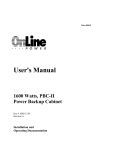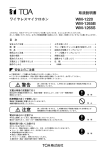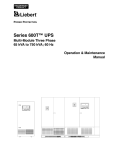Download Power Battery Company, Inc. Field Service Manual
Transcript
Power Battery Company, Inc. Field Service Manual Valve Regulated Lead Acid (VRLA) Battery Field Service and Application Manual First Edition February 2007 Table of Contents 1.0 Scope 2.0 Safety 3.0 Storage Requirements 4.0 Ventilation 5.0 Temperature 6.0 Floor Loading 7.0 Neutralizing Spilled Acid 8.0 Visual inspection and Open Circuit Voltage (OCV) Measurement 9.0 Safety Procedures and Tool List for System Maintenance 10.0 Battery Installation and Operating Instructions 11.0 Field Service Report Form 12.0 Power Battery Model Number Reference Guide 13.0 Contact Information Scope This manual has been designed to provide the user with some specific battery application and field service information. It has been divided into nine sections by subject matter for ease of use. By following these guidelines one can expect safe, reliable, cost-effective service from Power Battery V.R.L.A. batteries. Power Battery believes that with qualified experienced personnel, following these instructions step-by-step, adopting normal safety precautions for electrical installations, paying particular attention to those emphasized in the attached specification and with the safety features built into the cabinets there should be no reason for personnel to be exposed to undue electrical hazards. This information is presented in good faith, but no additional warranty is expressed or implied. In as much as any assistance furnished by Power Battery Company. Inc. with reference to the proper use of its products without charge, power Battery Company, Inc. assumes no obligation or liability therefore. 1.0 SAFETY General Safety Rules for Handling Power Battery Company, Inc. Batteries DO use qualified personnel only for battery handling and maintenance. DO follow all Power Battery and charger maintenance instructions. DO wear protective equipment (face shield, goggles, gloves) when working with or around battery systems. DO make sure that all charging/discharging circuitry is completely disconnected from the battery system before making or breaking any connections. DO check with Power Battery before making any design changes to the battery system. DO use proper lifting techniques when working with the batteries. DO NOT lift any battery by the battery terminals. DO NOT allow tools or unconnected cables to rest on top of the batteries or touch the battery terminals. DO NOT use power tools that can develop more torque than the torque specified for connections. DO NOT use any chemical cleaners to clean the batteries. DO NOT remove vent caps or add anything to the batteries. DO NOT smoke or carry open flames near any battery or system. DO NOT approach any energized battery system that shows signs of severe over charging or over discharging (severe swelling, cover deformation, vent caps missing). Disconnect and isolate the battery system from all charging and discharging circuitry before approaching the system. DO NOT circumvent any device installed by Power Battery or the Charger Manufacturer for the purpose of protecting the battery system. These devices include: Fuses and Circuit Breakers, Disconnects, Switches and any other protection devices. 2.0 Storage Requirements 3.0 Storage All lead-acid batteries will self-discharge when allowed to stand on open circuit. This self-discharge is due to "Local Action" caused by dissimilar metals (positive vs. negative plates) used within the cell's construction. The result of the self-discharge is loss of cell open circuit voltage, consequently loss of capacity. If allowed to progress beyond the normal limits, excessive plate sulfation may occur causing permanent loss of capacity and premature battery failure. These batteries have been designed to minimize the effects with the use of the purest plate materials available. This has resulted in a reduction of the self-discharge rate to approximately one-fifth of a conventional lead acid battery. The rate of self-discharge will also be dependent upon the battery's storage temperature. Lower storage temperatures will reduce the self-discharge rate; higher temperatures will increase the rate. A cool, dry area is the recommended environment in which batteries should be stored. They should also be placed away from any heat sources including heaters, steam pipes, equipment or in direct sunlight. The table below represents the maximum allowable storage time at various battery storage temperatures. Storage parameters Ambient Temperatures Typical storage time 0°F - 32°F 12 months 33°F - 65°F 9 months 66°F - 90°F 6 months 91°F - 105°F 3 months 106°F - 120°F 1 1/2 months Battery Open Circuit Voltage: A useful tool in determining the battery's state of charge while in storage is the open circuit voltage (O.C.V.). The O.C.V. is a relative measure of the electrolyte concentration (specific gravity) contained within the battery. The electrolyte specific gravity is a direct measure of the battery's state of charge and can be used to determine the percentage of battery capacity remaining at any given point. This relationship is exhibited on the "Battery Open Circuit Voltage vs. Percent Remaining Capacity" curve (DWG# BSD- OCV). From this curve it can be seen that a battery voltage of 1.98 V.P.C. (11.88 for 12 volts, 5.94 for 6 volts) or less will have zero percent capacity remaining. In order to prevent any possible permanent plate damage from occurring due to self-discharge, it is recommended that when any battery in storage has an O.C.V. corresponding to the 50% capacity level (12.40 for 12 volts, 6.20 for 6 volts), it should be promptly recharged. DWG. # BSD- OCV Notes Using these parameters, one can take advantage of the longest possible storage durations without subjecting the battery to any potential harm caused by the delirious effects of prolonged self- discharge. The open circuit voltage (O.C.V.) can also be useful in approximating the remaining storage time available before the batteries reach the minimum O.C.V. (12.40V / 12V or 6.20V / 6V) before recharge. A curve has been provided to show the relationship of "Battery O.C.V. vs. Percent Storage Time Remaining" (DWG. # BSD- OCV). To use this curve take the O.C.V. of the battery and locate the point on the curve which intersects with the percent remaining storage time. This percentage is then multiplied by the storage time and temperature parameters given earlier to calculate the approximate storage time remaining before required recharge. It should be noted that the battery's O.C.V has some limitations on its accuracy. The percent capacity remaining is within -10% or +10% if the battery has been on charge or discharge within the last 24 hours. After a battery has remained on open circuit for a minimum of 72 hours the accuracy increases to -2.5% or +2.5% The battery O.C.V. can also be used in approximating the state of charge after a discharge using the same parameters as described above. However, it should be noted that this does not apply for the percentage of remaining storage time curve as all batteries should be recharged immediately after a discharge. All batteries should be recharged using a constant voltage of 2.27 - 2.30 V.P.C., at 77°F, for a minimum of 24 hours or until the float current stabilizes for 3 consecutive hourly readings. Battery carton date coding All battery cartons are date coded with a recommended recharge data. The date code (month / year) has been calculated for "normal” storage temperature conditions (66°F 90°F) and dated 6 months from the battery's last full charge. The battery's O.C.V. should continue to be checked at frequencies described earlier to give a true indication of when a battery will require a recharge. Battery terminal date coding consists of the month and year date of manufacture located on the negative battery terminal unless noted otherwise. Due to the natural self-discharge of the batteries, many of the storage parameters discussed earlier would apply when "shutting down" and storing a battery system. As before, the battery's O.C.V. is a useful tool in determining when a recharge would be required. All batteries placed in storage should be fully charged before shutting down and disconnecting from the system. The batteries may also need to be relocated if the environment is not suitable for storage (refer to storage parameters). When shutting down a battery system that has been in use, some additional considerations will need to be made. First, and foremost, the batteries must be fully charged before the equipment is shutdown. Second, the battery must be disconnected (via disconnected, breaker, etc.) completely from the equipment circuitry. One must insure that all possible loads are also disconnected so that the batteries are not unknowingly discharging during the shutdown period. Examples of other small loads may be shunted devices or other small resistive loads tied into the circuit. As an additional safety measure one of the battery fuses or intercell connections can be removed. Caution: Be sure battery system is disconnected from circuit before removal of any intercell connectors. Finally, record the date when the system was shut down and include this with the regularly scheduled maintenance records for future use. It may also be advisable to place a recharge date directly on the batteries as an additional visual aid to indicate when a recharge would be required. Ventilation 4.0 Ventilation When Power Battery series of batteries are charged at constant potentials below 2.37 VPC at temperatures up to 92ºF, (33.33ºC) and below 2.25 VPC up to 107ºF, (41.67ºC) 100% of the gases produced are recombined internally so that no gas is evolved. If the batteries are charged at higher voltages or temperatures, small amounts of gas may be evolved. Recombination efficiency is about 90% at 2.5 VPC @ 107ºF (41.67ºC). Power Battery VRLA batteries internally recombine all gasses generated within the batteries if they are charged or maintained on float within the recommended charge conditions. If the batteries are charged at voltages above 2.37 VPC (14.22 volts for 12 volt batteries) small amounts of gas may be evolved, particularly if the batteries are above ordinary temperature. A typical UPS battery installation uses battery cabinets with an internal volume of 56 cubic feet (Power CR4). Such cabinets usually contain 40 batteries occupying 23 cubic feet and electronic gear occupying 1 cubic foot leaving 32 cubic feet of free air space. The cabinet has ventilations slots with a total open area of 0.32 square feet. Hydrogen will leave the cabinet both by diffusion through the ventilation slots (and other openings) and by convection. Calculations based on the known diffusivity of hydrogen show that a maximum equilibrium concentration of 0.062% hydrogen will be reached within the CR4 cabinet when the batteries are charged at 2.5 VPC at 77ºF (25ºC) without any convection. If the batteries are charged under the extreme condition of 2.5 VPC at 107ºF (41.67ºC) about 80ml per hour will escape from each battery so that diffusion alone will result from each battery so that diffusion alone will result in a maximum cabinet concentration of 0.23% hydrogen. Since some convection will occur, the actual hydrogen concentrations will be well below these calculated equilibrium concentrations. The calculation of Gas Produced and Recombination Efficiency is not strictly correct since some small current will be accepted by all batteries without the production of gas. The error is very small and, since the calculation provides a convenient way to compare recombinant batteries of different design, many battery researchers have used the method. The data shown in the table has been plotted on the attached charts that show Gas Recombination Efficiency and Actual Gas Evolution as a function of Cell Voltage. The minimum concentration of hydrogen in air that is required for combustion is 4.1%. The current IEEE standard for the maximum safe concentration of hydrogen in air is 2%. The maximum, diffusion limited, equilibrium concentration of 0.23% obtained at 2.5 VPC and 107ºF (41.67ºC) is about 10% of this. If charging is done under the more normal conditions of 2.37 VPC hydrogen concentration within the cabinet will not exceed 0.02% and will approach the natural atmospheric hydrogen concentration of 0.01%. If Power Battery VRLA batteries are operated within the recommended guidelines and if cabinet ventilation slots are not impeded, there is no possibility of reaching dangerous concentrations of hydrogen within the battery cabinet. Temperature 5.0 Temperature Heat is the worst enemy of any battery. Its effects must be seriously taken into account and steps must be taken to minimize these effects. The application parameters to do so are covered below. Battery system location is the first part of the application detail needed to properly size and use any battery. It is recommended that a battery system's average temperature be maintained between 68° (77°F). A cellto-cell variation of 5°F (maximum) is also highly desirable. When a system location calls for temperatures outside these parameters, applications engineering may use one of the following methods. Design the system with the added temperature environment controls ( ex: change o system location, forced air circulation and/or cooling provisions, etc.) or use the temperature compensation float voltage coefficient of + 0.0017 V.P.C. or -0.0017 V.P.C. per °F. For temperatures above 77°F subtract coefficient from float voltage. For temperatures below 77°F, add coefficient to float voltage. A battery system's discharge capacity: A battery system's discharge capacity is directly related to the battery's temperature. PRC Series batteries are rated 100% at 77°F. The percentage of capacity available at a specific rate of discharge can be taken directly from the "Percent Capacity VS. Temperature" curve (DWG# BTD-377) enclosed. To use, one must first select the rate of discharge closest to the actual rate the application calls for, then travel along the curve to the expected operating temperature on the horizontal axis. Now, find the point on the vertical axis that corresponds to the temperature and rate curve selected. Multiply this percent capacity by the ampere or wattage rate on the published discharge curves to arrive at the temperature corrected discharge rate. The designed float service life: The designed float service life of Power Battery batteries is 10 years at 77°F using a 2.27 - 2.30 V.P.C temperature compensated float charge voltage. The float service life is directly related to the application's operating temperature. For temperatures above 77°F standard, grid growth (corrosion) is accelerated and battery life is shortened. The actual amount in which the life will be affected is given on the "Temperature effects on long term float life" curve (DWG# BTD-277) enclosed. This curve was derived from experimentation based on the developments by the scientist E. Willihnganz in a paper presented in "Electrochemical Technology", Oct, 1968. This paper titled "Accelerated Life Testing of Stationary Batteries" describes the test procedures performed to obtain the experimental data on battery float service life. This procedure is the most widely accepted method of accelerated testing used today because the primary cause of battery failure, grid growth (corrosion), has been found to correspond with the failure mechanisms found in actual field tests. One final note with regards to the use of valve regulated lead acid batteries is that most immobilized electrolyte systems are less forgiving than the traditional flooded battery systems. These designs are such that many application advantages are inherent but careful attention must be paid to all the parameters of the application's environment. As discussed, with proper maintenance and monitoring of these parameters, the batteries will perform and provide the level of service in which they're designed. Float charge voltage: The selection and maintenance of a specific float charge voltage is essential to achieving the designed service life and rated capacity of the battery. If the float charge voltage is too high, more float charge current will flow through the battery causing accelerated grid growth (corrosion), hence shortening the battery service life. If the float charge voltage is too low, the battery will not be maintained in a full charge state. This will cause the accumulation of the lead sulfate, resulting in degradation of capacity, followed by a reduction in service life. Battery temperatures play an important role in the selection of the float charge voltage used in any stationary application. The PRC Series batteries are designed for 10 years full float charge operation @ 77°F and 2.27 - 2.30 V.P.C. When the application's environment is such that the battery's temperature varies from the 77°F standard, changes occur in the float charge voltage requirements. These changes are due to variations in the battery selfdischarge rate, internal resistance, current acceptance and electrolyte viscosity. It is therefore recommended that the float charge voltage be temperature compensated to accommodate the variations. Enclosed is a copy of the "Battery Temperature vs. Float Charge Voltage" curve (DWG# BTD-177) developed for this purpose. This curve can be used in one of two ways. If the average temperature profile of the application is a known constant or is well controlled, the float charge voltage can be set on the charger according to the compensation curve. If the application calls for unknown battery temperatures or variations (ex: day / night, winter / summer, ect.), the charger design can be modified to automatically compensate for these variations. This modification is relatively simple to accomplish, as the compensation factor is linear in nature over a wide range of temperatures. Please refer to the curve DWG # BTD-177 for further details. Floor Loading 6.0 Location and Mounting Mounting holes are provided on the cabinet for securing the cabinet to the floor when necessary. If a multi-cabinet system was installed, consult the inter-cabinet connection drawings, supplied with the system, for proper positioning and spacing between each cabinet. Cabinets must be bolted to the floor if UBC seismic zone and Underwriters Laboratories requirements are to be met. Cabinets may also have levelers, casters or both. When installed one or both should have been adjusted properly by a qualified service person. Some cabinets may not have levelers, casters or both; instead a floor loading plate may have been installed for proper cabinet weight distribution. NEUTRALIZING SPILLED ACID Sulfuric acid: Sulfuric acid is a strong corrosive. Contact with the acid can cause severe burns to the skin and eyes. Ingestion of sulfuric acid will cause gastro intestinal tract burns. First aid • • • Sulfuric acid: Skin contact: Flush with water for 15 minutes. Remove contaminated clothing. Call physician if contact area is large, or if blisters form. Eye contact: Call physician immediately, flush with water until physician arrives. Ingestion: Call physician DO NOT INDUCE VOMITING. DO NOT GIVE ANYTHING TO AN UNCONSCIOUS PERSON. Spill or leak procedures: If sulfuric acid is spilled from a battery, neutralize the acid with sodium bicarbonate (baking soda), sodium carbonate (soda ash) or calcium oxide (lime). Flush the area, and dispose of as hazardous waste. 7.0 Waste disposal method: Spent lead acid batteries are disposed of using three (3) acceptable methods: send the batteries to: 1. Licensed secondary lead smelters for recycling 2. Reputable battery handlers 3. Reputable scrap dealers. If the user has to transport these batteries to the smelters, the user must follow department of transportation (DOT) regulations. A copy of this material safety data she et must be supplied to any scrap dealer or secondary lead smelter. Follow applicable Federal, State, and Local regulations. Protection: Skin - rubber gloves, apron. Respiratory: Protective equipment must be worn if the battery is cracked or otherwise damaged. HEPA respirator should be worn during reclaim operations, if the OSHAPEL is exceeded. Eyes safety: Goggles, face shield. Electrical safety: Due to the low internal resistance of Power Batteries and high power density, high levels of short circuit current can be developed across the battery terminals. Do not rest tools or cables on the battery. Use insulated tools only. Follow any installation instructions and diagrams when installing or maintaining battery systems. VISUAL INSPECTION AND OPEN CIRCUIT VOLTAGE (OCV) MEASUREMENT 8.0 Battery Inspection: A detailed visual inspection of each battery should be performed. Items to be checked are: 1. Signs of damage to the case, cover or terminals. 2. Staining of the case, terminals or surrounding areas. 3. Excessive swelling of battery case. 4. Evidence of melting or thermal damage to the case cover and terminal post-seal. 5. The supporting cabinet, rack or tray should be checked confirming that there is no physical damage or corrosion. Cable Connections: Care must be taken to insure that all cables within the cabinet(s) are mechanically and electrically secure. All connections should be retorqued annually to 5 IN-LB less than initial values specified on the battery label. For first time battery cable installation, connections should be torqued to the stipulated value on the battery label located on the battery. In all other cases, torque cable connections to 5 IN-LB less than the labeled torque value. The connections must be retorqued with a torque wrench. Using only a wrench will cause strain on the terminal and internal battery connections resulting in permanent battery damage. The retorqing is necessary to insure good low resistance connections and equal battery float voltage distribution. Loose connections can result in high power drains and high terminal temperatures on discharge, resulting in reduced capacity, possible personal injury and equipment damage. Caution: DO NOT over-torque terminal connections. Excessive pressure on the terminal will cause creep flow of lead, resulting in low contact pressure, loose connections, and possible permanent damage to the terminals. SAFETY PROCEDURES AND TOOL LIST NEEDED FOR SYSTEM MAINTENANCE 9.0 Protective Equipment: 1. Goggles and face shields. 2. Acid-resistant insulated gloves. 3. Protective aprons and overshoes. 4. Lifting devices of adequate capacity, when required. 5. All tools used during battery installation and system hook-up must be insulated. 6. Use rubber mats on floor and over batteries when working on the battery system connections. Safety Procedures: 1. Inspect all lifting equipment for functional adequacy and to make sure it is of sufficient capacity to lift the weight involved. 2. Prohibit smoking and open flame, and avoid arcing in the immediate vicinity of the battery. 3. Ensure that adequate illumination requirements for inside the battery system are met. 4. Always make sure that there is an unobstructed path from the battery area to the exit. 5. Avoid static buildup by having personnel contact ground prior to working on batteries. 6. Servicing of battery or batteries should be performed or supervised by personnel knowledgeable of batteries and the required precautions. Keep unauthorized personnel away from batteries. 7. When replacing batteries, use the same number and type specified on the battery or drawing. The battery or batteries should be valveregulated lead acid type. 8. Caution – Do not dispose of battery or batteries in a fire. The battery may explode. 9. Caution – Do not open or mutilate the battery or batteries. Released electrolyte is harmful to the skin and eyes. It may be toxic. 10. Caution – A battery can present a risk of electrical shock and high short circuit current. Observe proper precautions. 11. Proper disposal of battery or batteries is required. Refer to your local codes for disposal requirements. 12. The following safety procedures shall be followed: A. Remove watches, rings, and other metal objects. B. Use tools with insolated handles. C. Where rubber gloves and boots. D. Do not lay tools or metal parts on top of batteries. E. Disconnect charging source prior to connecting or disconnecting battery terminals. 13. Determine if the battery is inadvertently grounded. If inadvertently grounded, remove source of ground. Contact with any part of a grounded battery can result in electrical shock. The likelihood of such shocks will be reduced if such grounds are removed during maintenance. This paragraph is applicable to a UPS and a remote battery supply not having a grounded supply circuit. Tool List needed for System Maintenance: 1. Digital Voltmeter: 3-1/2 digit minimum 0.25% accuracy, rated 600 V.D.C. minimum. Due to the close tolerances needed for battery maintenance (typically 20-40 MV on a 20V scale) analog meters are not recommended. The voltmeter should be checked and calibrated at yearly intervals. 2. Thermometer: Thermocouple contact type, 1°F (0.5°C) accuracy. Mercury in glass thermometers can be used for ambient air temperature readings. However, a surface contact type is needed for individual battery temperatures. Infrared sensing optical thermometers may also be used for this application. 3. Capacity Tester: This can be an external load tester or the UPS. It is recommended that all battery systems be tested for rated capacity at least every two years or until the batteries reach 85% capacity. Annual testing should be performed thereafter, until the batteries reach 80% capacity. 4. Microhmeter: Biddle Instrument-DLRO or equivalent low resistance ohmmeter. 5. Torque Wrench: 0-120 in-lbs, 5 in-lbs graduations. The wrench and all other equipment used in battery maintenance must be insulated to prevent short circuit and calibrated every year. 6. Other tools needed: End wrenches (insulated), screwdrivers (insulated), socket sets (insulated), plastic handled cleaning brushes. All tools must be insulated to ensure the safety needed battery system maintenance. Battery Installation and Operating Instructions 10.0 Applicable for CG-CSL, CSL, MC, MCG, MRV, PL, PL-C, PM, PM-F, PRC PS, SL, SLF, TC, TG, TL, TL-SLC, WC and WCG Batteries General Information In normal use, POWER BATTERY VRLA batteries will emit no gases. However there is the possibility that under abnormal operating conditions or as a result of damage or abuse; the batteries might release hydrogen. In order to insure the proper function of its batteries POWER BATTERY strongly recommends compliance to its operating installation and maintenance instructions. Receiving Upon receipt of shipment all cartons should be inspected and matched against packing list. Any shortages of batteries, cables or hardware should be immediately reported to Power Battery. Any damages upon receipt of shipment should be claimed as freight damage to the shipper. No replacement will be made unless missing or damaged items are properly noted on receiving documents before customer signature. Storage All batteries are shipped in a charged condition. If batteries are not installed immediately they should be stored in a cool, clean and dry area. These batteries should ideally be stored on a float charge. If not, then batteries should be recharged when open circuit voltage falls to 2.07 volts per cell, and/or every 6 months, whichever occurs first (see charging section for specifications). Location Before proceeding with installation, review battery system drawings and assemble according to provided instructions. Normal battery operating temperatures are between 68°F (20°C) and 77°F (25°C). Cabinet enclosed battery systems are shipped fully assembled and internally pre-wired. Internal battery connections should be retorqued annually. Install cabinet(s) in a cool, clean and dry area. Battery Connections When installing batteries in a system, prepare contact surface of terminals to a clean, metallic finish. Use a wire brush to clean battery terminals and a plastic bristle brush to clean cable lugs. Apply a thin coat of an approved anti-corrosive compound to all contact surfaces of battery terminals. Torque all connections to the recommended value. Apply a final thin coat of anti-corrosive compound to all metal surfaces. Charging Batteries are shipped from Power Battery at approximately 95% capacity, and will attain 100% capacity after 6 months on float charge. Batteries must be maintained on float charge and should be fully recharged within 24hrs after any discharge. A high rate charge may be used to speed up the charging process, but only after a discharge. High rate charging should last for 6-8 hrs. maximum, then all batteries should be put back on float charge. All charging must be at fixed voltage. Recommended Charging Parameters: • • Float voltage: 2.27 - 2.30 volts/cells High-charge voltage: 2.31 - 2.35 volts/cells => Above 2.37 volts/cell batteries may emit hydrogen gas => Average ambient temperature: 77 °F (25°C) Maintenance The following minimum maintenance procedures must be followed and recorded in the Field Service Report. Insufficient records and/or failure to perform maintenance on the battery system may conditionally void the warranty. Monthly Inspections: 1. 2. 3. 4. 5. General inspection of batteries, rack(s) or cabinet(s) Check charger voltage and current operation. Measure float charge voltage at battery terminals. Measure charge float current. Check battery environment and ambient temperatures. Semi-Annual: (perform monthly inspection plus) 1. Spot-check individual battery temperatures. 2. Measure individual battery float voltages. Annual: (perform semi-annual inspection plus:) 1. 2. 3. 4. 5. 6. Detailed visual inspection of individual batteries. Inspected all connections for cleanliness, corrosion, etc. Measure micro OHM meter value of all terminal connections. Restore all connections as required. Retorque all connections to recommended values. Perform general system maintenance, clean batteries, cabinet(s) or rack(s). Bi-Annual: (perform annual inspection plus:) 1. Perform discharge test at rated capacity monitoring parameters continuously. Note: Some larger and/or custom designed battery systems may require more frequent specialized maintenance inspections. Safety tips: 1- Limit access to authorized personnel only. 2. Read all instructions and specifications prior to performing work on the batteries. 3. Do not smoke, light matches or cause sparks near any storage battery. 4. Remove rings and metal watchbands and jewelry before working on batteries. 5. Do not place tools or metal objects on battery. 6. Use insulated tools when working on battery. 7. Make sure installation is in accordance with engineering instructions prior to battery start-up. 8. Review all battery specifications from instructions. 9. Perform routine maintenance from instructions. Field Service Report Form: 11.0 POWER BATTERY MODEL NUMBER REFERENCE GUIDE AH AH TERM. DIMENSIONS L" X W" X C/20 C/8 TYPE H" CURRENT MODEL # TERM. TYPE NEW MODEL # PRC1225X or TC-1225X L PRC12225 or TC-1225 L PRC1230X or TC-1230X L NONE L PRC1235X or TC-1235X L PRC1235L or TC-1235L PRC1250XL or TC-1250XL L 24 6.5 X 6.81 X 4.94 L 32 7.1 X 5.18 X 7.19 PRC1250S or TC-1250S S 50 8.6 X 5.36 X 8.65 S 63 10.2 X 6.67 X 9.44 COMMENTS DISCONTINUED - 7/2000 PRC1265 or TC-1265 L PRC-1265 or TC-1265S PRC1280X or TC-1280X L NONE PRC1290X or TC-1290X L PRC1290S or TC-1290S S 76 10.2 X 6.67 X 9.44 PRC12100X or TC-12100X L PRC12100S or TC-12100S S 91 12.0 X 6.86 X 9.58 PRC12110X or TC-12110X L NONE DISCONTINUED - 7/2000 DISCONTINUED - 7/2000 PRC12120X or TC-12120X L PRC12120S or TC-12120S S 110 13.5 X 6.81 X 9.2 NEW CASE W/HANDLE & COVER PRC12150X or TC-12150X L PRC12150C or TC-12150C C 130 13.5 X 6.81 X 11.5 NEW CASE W/HANDLE & COVER PRC12150S or TC-12150S S PRC12150C or TC-12150C C 130 13.5 X 6.81 X 11.5 NEW CASE W/HANDLE & COVER PRC6165X or TC-6165X L NONE PRC6200X or TC-6200X L PRC6200S or TC-6200S S 208 10.62 X 7.38 X 11.63 PRC6225X or TC-6225X L PRC6225S or TC-6225S S 220 10.62 X 7.38 X 11.63 SLF-12105 C NO CHANGE C 91 21.0 X 4.28 X 9.63 SLF-12205 C NO CHANGE C 184 21.12 X 8.7 X 10.1 MC-90X S DISCONTINUED - 7/2000 MC-90 S 76 10.91 X 6.67 X 9.44 MC-90P C 76 10.23 X 6.67 X 9.04 MC-100 S 91 12.06 X 6.68 X 9.58 DID NOT EXIST MC-100P C 91 12.06 X 6.68 X 9.09 DID NOT EXIST MC-120 S 110 13.5 X 6.81 X 9.20 DID NOT EXIST MC-120P C 110 13.5 X 6.81 X 8.45 DID NOT EXIST MC-150 S 130 13.5 X 6.81 X 11.5 DID NOT EXIST MC-150P C 130 13.5 X 6.81 X 10.82 DID NOT EXIST TL-1230 C 29 DID NOT EXIST TL-1245 C 45 8.61 X 5.36 X 8.20 DID NOT EXIST TL-1270 C 68 10.23 X 6.67 X 9.04 DID NOT EXIST TL-1280 C 82 12.06 X 6.68 X 9.09 DID NOT EXIST TL-1295 C 96 13.5 X 6.81 X 8.45 DID NOT EXIST TL-12120 C 118 13.5 X 6.81 X 10.82 DID NOT EXIST TL-6195 C 193 10.7 X 7.38 X 10.93 DID NOT EXIST TL-2480 C 480 10.7 X 7.38 X 10.94 DID NOT EXIST MC-100X S 7.71 X 5.18 X 7.19 CSL-1280 C NO CHANGE C 82 21.0 X 4.28 X 9.63 CSL-12100 C NO CHANGE C 100 21.0 X 4.28 X 9.63 CSL-12170 C NO CHANGE C 170 21.12 X 8.7 X 10.1 CG-30-12SLC SLC TL-1230SLC C 30 7.17 X 5.18 X 7.38 CG-45-12SLC SLC TL-12445SLC C 45 8.61 X 5.36 X 8.65 DID NOT EXIST TL-1280SLC C 82 12.06 X 6.68 X 9.54 TC-2550XC C TC-2550C C 510 10.7 X 7.38 X 10.93 TC-2600XC C TC-2600C C 552 10.7 X 7.38 X 10.94 12.0 HEAVY DUTY CASE HEAVY DUTY CASE HEAVY DUTY CASE HEAVY DUTY CASE General Specifications Continued Rating Battery model number Standard / Flame returdant Volts AH KW PRC/TC-1225 12 24 0.441 PRC/TC-1235L 12 33 0.712 PRC/TC-1255S 12 55 1.100 PRC/TC-1265S 12 63 1.107 PRC/TC-1290S 12 76 1.701 PRC/TC-12100S 12 91 1.909 PRC/TC-12120S 12 110 2.227 PRC/TC-12140C 12 118 2.850 PRC/TC-12150C 12 130 3.030 PRC-636 6 36 0.295 PRC/TC-6200S 6 208 1.856 PRC/TC-6225S 6 220 2.058 TC-2550C 2 510 1.063 TC-2600C 2 552 1.150 SLF-12105 12 91 1.909 SLF-12120 12 110 2.310 SLF-12205 12 184 3.946 SLF-12250 12 220 5.030 Dmensions - in / mm L W H 6.50 / 165 6.81 / 173 4.94 / 125 7.71 / 196 5.18 / 132 7.19 / 183 9.00 / 229 5.50 / 140 9.00 / 229 10.2 / 259 6.67 / 169 8.85 / 225. 10.2 / 259 6.67 / 169 8.85 / 225. 12.0 / 305 6.68 / 170 8.85 / 225. 13.5 / 344 6.76 / 172 9.25 / 235 13.5 / 344 6.76 / 172 10.87 / 276 13.5 / 344 6.76 / 172 10.87 / 276 6.25 / 159 3.35 / 85 7.00 / 178 10.7 / 272 7.38 / 187 11.6 / 295 10.7 / 272 7.38 / 187 11.6 / 295 10.7 / 272 7.38 / 187 10.9 / 278 10.7 / 272 7.38 / 187 10.9 / 278 21.0 / 534 4.28 / 109 9.63 / 245 21.0 / 534 4.28 / 109 9.63 / 245 21.1 / 536 8.46 / 215 10.1 / 256 21.1 / 536 8.46 / 215 10.1 / 256 Weight lbs / kgs 21.5 / 9.75 26.7 / 12.1 37.0 / 16.8 50.7 / 16.0 60.6 / 27.5 71.9 / 32.7 81.8 / 37.2 100.1 / 45.5 100.1 / 45.5 13.0 / 5.90 77.2 / 35.1 82.2 / 37.4 81.9 / 37.2 87.0 / 39.6 74.0 / 33.6 78 / 35.4 146.5 / 66.5 150 / 67.9 HIGH-RATE SERIES-WATT CONSTANT CURRENT DISCHARGE RATES @ 77º F (25º C) Battery V.P.C. 5 10 15 20 30 60 PRC/TC 1225 12 1.67 691 525 425 358 275 169 - - - - - - 1.75 627 478 403 345 266 166 122 97 55 39 31 22 PRC/TC 1235L 12 12 PRC/TC 1265S 12 PRC/TC 1290S 12 PRC/TC 12100S PRC/TC 12120S 12 12 90 2 4 6 8 12 1.8 578 455 376 322 254 160 119 95 53 38 30 21 1.67 1612 1038 785 634 467 275 - - - - - - 1.75 1417 956 735 596 440 260 199 165 95 68 53 37 1.8 1320 918 713 582 433 257 188 151 88 63 49 34 1.67 2327 1549 1236 1020 750 440 - - - - - - 1.75 1920 1448 1153 963 723 428 314 253 148 107 84 57 1.8 1800 1352 1093 928 596 423 309 248 145 103 80 55 1.67 1850 1360 1107 922 719 443 - - - - - - 1.75 1708 1280 1050 890 680 434 319 255 148 105 83 60 1.8 1567 1200 970 820 640 410 309 247 141 102 80 59 1.67 3049 2292 1800 1464 1074 630 - - - - - - 1.75 2711 2045 1630 1360 1022 565 456 365 209 152 118 81 1.8 2542 1911 1543 1311 1005 559 408 329 191 136 106 73 1.67 3517 2640 2100 1740 1302 732 - - - - - - 1.75 3223 2431 1937 1617 1215 719 526 442 255 184 143 98 1.8 3023 2272 1834 1558 1194 710 518 418 243 174 135 93 1.67 4210 3035 2400 1950 1436 847 - - - - - - 1.75 3931 2836 2260 1887 1417 838 614 506 292 210 163 112 1.8 3686 2650 2140 1818 1393 829 605 488 284 202 157 108 712 706 - - - - - - PRC/TC 12140C 12 1.67 1.75 1.8 4818 4499 - 3630 3391 - 2850 2729 - 2292 2235 - 1685 1664 - 984 975 - PRC/TC 12150C 12 1.67 5480 3900 3030 2520 1830 1128 - - - - - - 1.75 5117 3643 2902 2458 1807 1117 771 650 368 253 204 136 1.8 4600 3405 2748 2368 1775 1108 761 583 339 242 187 129 1.67 3019 2292 1856 1562 1203 740 - - - - - - 1.75 2746 2071 1759 1506 1164 724 532 424 241 172 135 97 PRC/TC 6200S 6 PRC/TC 6225S 6 TC2550C New Watts per battery @ 77º F (25º C) – minutes/hours Volts PRC/TC 1255S New Final Model 2 TC2600C 2 SLF12105 12 1.8 2527 1990 1645 1407 1112 700 518 414 233 166 131 93 1.67 3348 2542 2058 1691 1271 782 - - - - - - 1.75 3041 2318 1951 1631 1229 765 562 448 255 182 143 102 1.8 2802 2207 1824 1523 1174 739 547 437 246 175 138 98 1.67 – – – – 1063 665 - - - - - - 1.75 – – – – 1017 647 462 356 192 134 104 72 1.8 – – – – – 616 436 340 185 129 100 70 1.67 – – – – 1150 720 - - - - - - 1.75 – – – – 1100 700 500 385 208 145 112 78 1.8 1.67 – 3257 – 2454 – 1909 – 1564 – 1161 666 685 471 - 368 - 200 - 140 - 108 - 76 - 1.75 3041 2293 1827 1525 1146 678 496 409 236 170 132 91 1.8 2852 2143 1730 1470 1126 670 489 394 229 164 127 88 334 325 265 256 149 144 96 93 SLF12120 12 1.67 1.75 1.8 3319 3016 2779 2520 2356 2187 2040 1934 1808 1719 1656 1547 1324 1280 1221 814 796 769 596 585 569 466 454 SLF12205 12 1.67 5021 4654 4331 3946 3714 3471 3194 3075 2921 2370 2321 2230 1384 1368 1340 1019 996 - - - - - 838 477 349 272 187 1.8 6953 6281 5704 801 460 328 256 175 1.67 7950 6280 5030 4085 3070 1740 - - - - - - 1.75 7490 6040 4730 3867 2860 1700 1286 1029 559 398 319 - 1.8 6800 5290 4300 3690 2700 1640 1211 970 536 379 301 - SLF12250 1.75 12 • • • • • • • • * 15 minutes to 10.02 volts (1.67 volts per cell). ** 30 minutes to 10.02 volts (1.67 volts per cell). For extended discharge rates on any one battery, please click below on the battery model number * 15 minutes to 10.02 volts (1.67 volts per cell). ** 30 minutes to 10.02 volts (1.67 volts per cell). For extended discharge rates on any one battery, please click below on the battery model number Obsolete models - PRC/TC-1230X, PRC/TC-1280X, PRC/TC-12110X, PRC/TC-6165X Specifications are subject to change. No transport restrictions Surface transport • • • Classified as non-hazardous material as relates to DOT-CFR Title 49 part 171-189 Marine transport. Classified as non-hazardous material as per IMDG amendment 27 Air transport. Complies with IATA / ICAO, special provision A67. No transport restrictions • • • Surface transport. Classified as non-hazardous material as relates to DOT-CFR Title 49 part 171-189. Marine transport. Classified as non-hazardous material as per IMDG amendment 27. Air transport. Complies with IATA / ICAO, special provision A67. Power Battery has two main headquarters and representation worldwide Headquarters • Corporate Headquarters Power Battery Company Inc. 25 McLean Blvd. Paterson N.J. U.S.A. 07514-1507 Tel: 1 (973) 523-8630 Fax: 1 (973) 523-3023 • Canadian Headquarters Power Battery (Iberville) Ltd. 770 Thomas Avenue St-Jean-sur-Richelieu (Québec) Canada J2X 5E7 Tel: 1 (450) 346-3273 Fax: 1 (450) 346-8003 • • To contact our headquarters, fill out the form below. To find a specific Power Battery Employee. Check our worldwide employee directory. To request literature from Power Battery, you can use our online literature request form. • 13.0













































